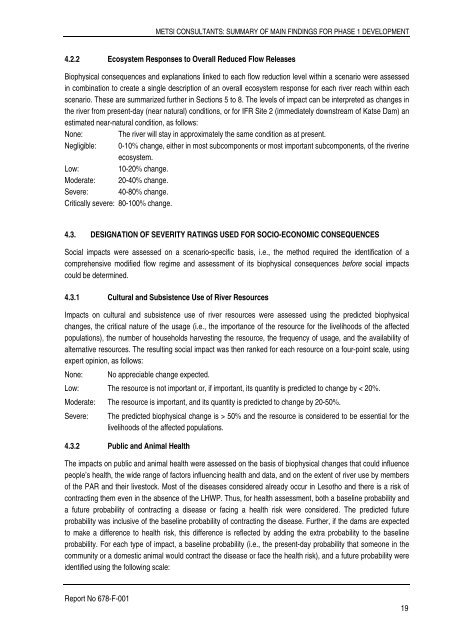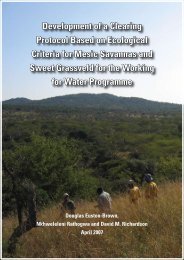Metsi Consultants - DWA Home Page
Metsi Consultants - DWA Home Page
Metsi Consultants - DWA Home Page
You also want an ePaper? Increase the reach of your titles
YUMPU automatically turns print PDFs into web optimized ePapers that Google loves.
Report No 678-F-001<br />
METSI CONSULTANTS: SUMMARY OF MAIN FINDINGS FOR PHASE 1 DEVELOPMENT<br />
4.2.2 Ecosystem Responses to Overall Reduced Flow Releases<br />
Biophysical consequences and explanations linked to each flow reduction level within a scenario were assessed<br />
in combination to create a single description of an overall ecosystem response for each river reach within each<br />
scenario. These are summarized further in Sections 5 to 8. The levels of impact can be interpreted as changes in<br />
the river from present-day (near natural) conditions, or for IFR Site 2 (immediately downstream of Katse Dam) an<br />
estimated near-natural condition, as follows:<br />
None: The river will stay in approximately the same condition as at present.<br />
Negligible: 0-10% change, either in most subcomponents or most important subcomponents, of the riverine<br />
ecosystem.<br />
Low: 10-20% change.<br />
Moderate: 20-40% change.<br />
Severe: 40-80% change.<br />
Critically severe: 80-100% change.<br />
4.3. DESIGNATION OF SEVERITY RATINGS USED FOR SOCIO-ECONOMIC CONSEQUENCES<br />
Social impacts were assessed on a scenario-specific basis, i.e., the method required the identification of a<br />
comprehensive modified flow regime and assessment of its biophysical consequences before social impacts<br />
could be determined.<br />
4.3.1 Cultural and Subsistence Use of River Resources<br />
Impacts on cultural and subsistence use of river resources were assessed using the predicted biophysical<br />
changes, the critical nature of the usage (i.e., the importance of the resource for the livelihoods of the affected<br />
populations), the number of households harvesting the resource, the frequency of usage, and the availability of<br />
alternative resources. The resulting social impact was then ranked for each resource on a four-point scale, using<br />
expert opinion, as follows:<br />
None: No appreciable change expected.<br />
Low: The resource is not important or, if important, its quantity is predicted to change by < 20%.<br />
Moderate: The resource is important, and its quantity is predicted to change by 20-50%.<br />
Severe: The predicted biophysical change is > 50% and the resource is considered to be essential for the<br />
livelihoods of the affected populations.<br />
4.3.2 Public and Animal Health<br />
The impacts on public and animal health were assessed on the basis of biophysical changes that could influence<br />
people’s health, the wide range of factors influencing health and data, and on the extent of river use by members<br />
of the PAR and their livestock. Most of the diseases considered already occur in Lesotho and there is a risk of<br />
contracting them even in the absence of the LHWP. Thus, for health assessment, both a baseline probability and<br />
a future probability of contracting a disease or facing a health risk were considered. The predicted future<br />
probability was inclusive of the baseline probability of contracting the disease. Further, if the dams are expected<br />
to make a difference to health risk, this difference is reflected by adding the extra probability to the baseline<br />
probability. For each type of impact, a baseline probability (i.e., the present-day probability that someone in the<br />
community or a domestic animal would contract the disease or face the health risk), and a future probability were<br />
identified using the following scale:<br />
19

















